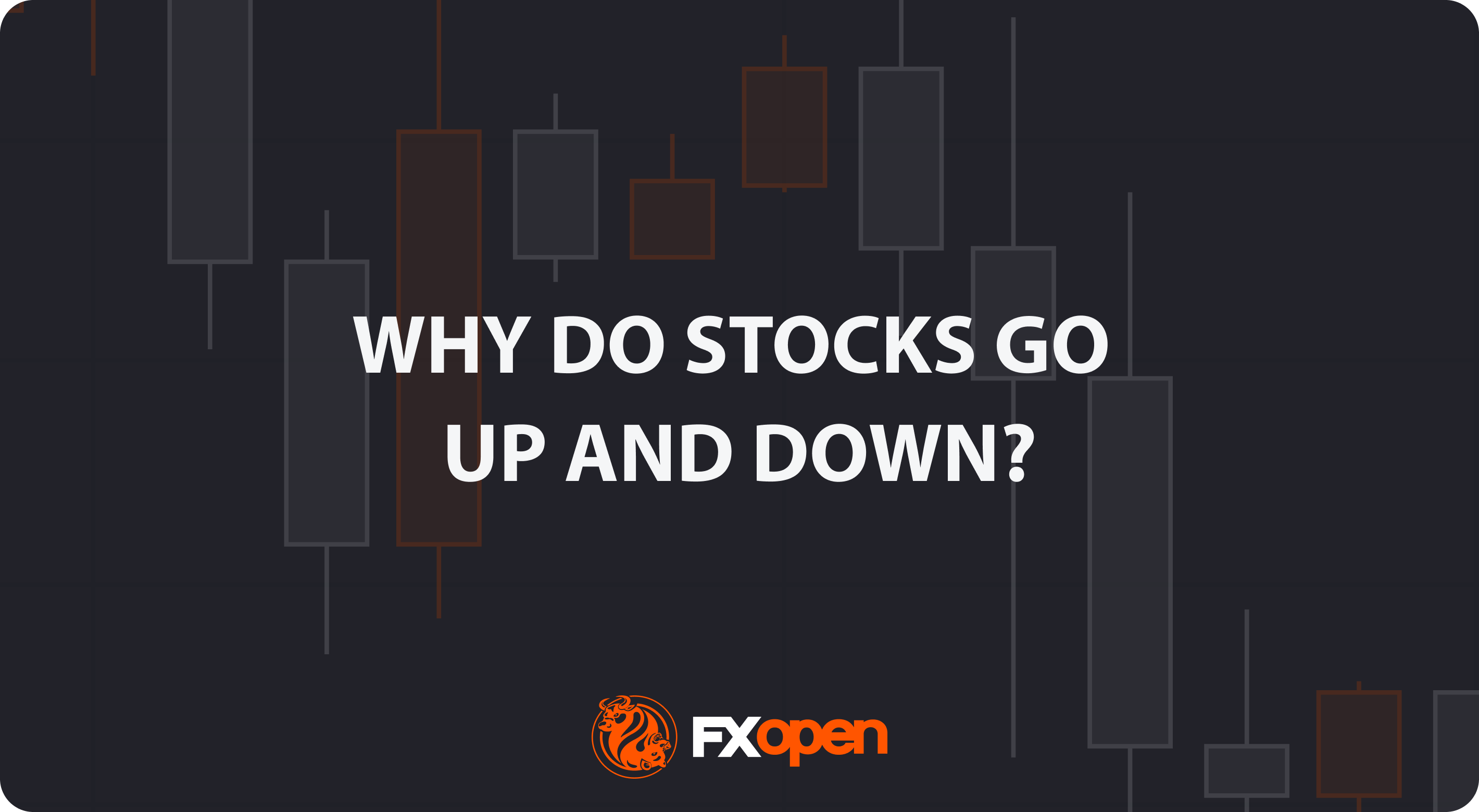FXOpen

Cryptocurrencies, with their unique economic models, have transformed our understanding of inflation and deflation. In this article, we’ll delve into how inflation works in crypto, its effects, what deflation is, and how you can manage the risks of both.
The Concept of Inflation in Crypto
In traditional finance, inflation represents the continuous upward shift in the prices of goods and services, thereby decreasing the currency's purchasing power.
Unlike fiat currencies, which are regulated and managed by central banking systems, cryptocurrencies function as decentralised entities. Their supply mechanics aren't influenced by government policy but by pre-established protocols. While many cryptocurrencies have predetermined limits on their total supply, some do not.
But what is inflation in crypto? In discussing cryptocurrency and inflation, we need to acknowledge that inflation here doesn't reflect rising prices; it pertains to the increase in the supply of coins or tokens.
Crypto inflation refers to the infinite growth in the total number of tokens or coins available in the market, e.g. Dogecoin. It has an unlimited supply, meaning that supply inflation could eventually outpace demand and devalue DOGE.
Bitcoin is inflationary to a point, with new Bitcoins added to circulation through mining rewards. However, it also has a disinflationary mechanism built-in: “halving,” where the mining reward is cut by 50% roughly every four years as the number of Bitcoins grows nearer to its fixed supply limit of 21 million.
Ethereum, contrasting with Bitcoin, does not have a fixed limit, so Ether is considered an inflationary token, but it controls ETH issuance and inflation through a combination of block rewards and, recently, transaction fee burns.
Factors Influencing Inflation Rates
Various elements determine crypto inflation rates.
Supply Schedule
Each cryptocurrency typically has a predetermined supply schedule embedded in its protocol, determining how new coins are introduced. Bitcoin's periodic halving events, for instance, slow its supply growth.
Tokenomics
The economic models governing cryptocurrencies, known as tokenomics, play a pivotal role in shaping inflation. Tokenomics includes factors like rewards for miners or validators, staking returns, and other incentives, which can increase the circulating supply and have an inflationary effect.
Coin Burning
Some crypto projects implement mechanisms where a portion of tokens is intentionally destroyed or "burned." This act reduces the total circulating supply, potentially counteracting inflationary pressures. Ethereum's EIP-1559 upgrade introduced such a mechanism where some transaction fees get burned, e.g. if Ethereum had a 5% inflation, token burning could reduce it to 3%.
Market Demand
Just like in traditional economies, demand relative to supply can influence inflation. If a large coin supply is met with limited demand, its value can decrease, reflecting inflationary tendencies.
How Does Inflation Affect Cryptocurrency?
Inflation in the cryptocurrency market can have multifaceted impacts, often distinct from those in traditional economies. Here are some of its repercussions:
- Price Suppression: If not met with proportional demand, a significant influx of new coins in the market can suppress a cryptocurrency's price.
- Perception and Trust: Unanticipated or constant inflation might weaken the community's faith in a digital asset. In crypto, trust is paramount and can directly affect perceived value.
- Holder Behavior: Surging inflation can alter how investors treat their holdings. A depreciating currency might prompt more sales, causing market volatility.
- Adoption Barriers: Chronic inflation could discourage using a cryptocurrency for daily transactions. Users and merchants could be hesitant to transact in a currency with fluctuating value.
- Competitive Dynamics: In the diverse world of crypto, high inflation might render a coin less appealing compared to stable or deflationary counterparts.
What Is a Deflationary Currency?
So what is deflation in crypto? A deflationary cryptocurrency is designed to decrease in supply over time or has a mechanism that reduces the total number of tokens in circulation. Unlike inflationary currencies, which increase in supply and can potentially lose value, deflationary models aim to increase scarcity and, theoretically, boost the currency's value over time.
Bitcoin is often cited as a deflationary example due to its capped maximum supply of 21 million coins. While its circulating supply does increase over time, this cap will eventually stop any more Bitcoins from entering the market. As some investors will gradually lose their coins (e.g. losing a USB drive), this introduces a deflationary element.
BNB, or Binance Coin, provides a real-world example of a deflationary mechanism in action with its "burning" process. Periodically, Binance, the company behind BNB, purposefully destroys, or "burns," a portion of the BNB tokens each quarter, aiming to reduce its circulating supply to 100 million BNB (from the initial 200 million). The hope is, with less BNB in circulation, each coin's value might rise, making it more valuable for its holders.
Risks of Crypto Deflation
While deflation might seem like a boon for crypto holders, there are some risks to be aware of:
- Hoarding Behaviour: As value rises, users might hoard coins, expecting further appreciation, which can stifle spending and circulation.
- Stagnant Growth: Reduced spending can lead to lesser economic activity on a platform, potentially hindering development and adoption.
- Exclusion: High prices might deter new entrants, making the crypto less accessible to potential users.
- Speculative Bubbles: Excessive demand based on deflationary predictions can cause market bubbles to burst.
- Centralisation Concerns: Major holders might gain undue influence as coins become scarcer.
Managing Inflation and Deflation Risks
Navigating the crypto landscape requires a keen understanding of inflationary and deflationary tendencies, posing unique risks and opportunities. To manage these risks, traders may consider the following techniques:
- Diversification: Allocate investments across various coins, balancing between inflationary and deflationary assets. This can offset potential losses from one while gaining from the other.
Moreover, to diversify your portfolio further across global financial markets, you can consider using FXOpen’s free TickTrader platform, which offers real-time insights into various asset classes.
- Staying Informed: Constantly monitor coin supply mechanics, such as halvings or burn events, as they can influence price trajectories.
- Evaluating Tokenomics: Understand the underlying economic models of a cryptocurrency. Factors like block rewards, staking incentives, and transaction fees can affect supply dynamics.
- Monitoring of External Factors: Regulatory changes, technological innovations, and market sentiment can magnify or mitigate the impacts of inflation or deflation.
- Considering Long-term Perspective: Short-term fluctuations are common in cryptocurrencies. A longer-term perspective can help investors see beyond immediate supply changes, focusing on inherent value and utility.
The Bottom Line
In summary, cryptocurrencies introduce a complex interplay between inflationary and deflationary dynamics, distinct from traditional financial systems. While their decentralised nature offers novel supply mechanisms, it's vital for traders to understand these intricacies. If you’re eager to delve into the broader financial markets beyond crypto, you can take the next step and open an FXOpen account to gain access to a wide variety of forex pairs, stocks, and commodities.
At FXOpen UK and FXOpen AU, Cryptocurrency CFDs are only available for trading by those clients categorised as Professional clients under FCA Rules and Professional clients under ASIC Rules, respectively. They are not available for trading by Retail clients.
This article represents the opinion of the Companies operating under the FXOpen brand only. It is not to be construed as an offer, solicitation, or recommendation with respect to products and services provided by the Companies operating under the FXOpen brand, nor is it to be considered financial advice.
Stay ahead of the market!
Subscribe now to our mailing list and receive the latest market news and insights delivered directly to your inbox.








